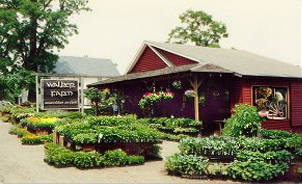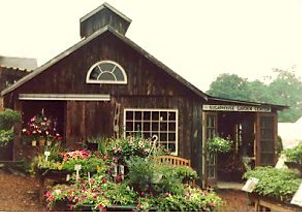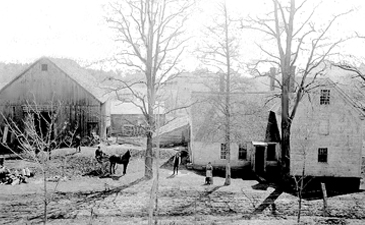 When Captain Issac Miller built the first frame house in Dummerston in 1770, he probably didn’t envision that 200 plus years in the future, Nicotiana Alata “Fragrant Cloud” would be helping to pay the taxes. Coming from the Worcester, Massachusetts area, Mr. Miller was employed to lay out the town in 100 acre lots. Lucky for us, his horticultural descendants, “He selected Lot #11 which extended all the way to the river with good flat tillable land for his farm.”* Issac had also been active in the struggle for an independent Vermont and in 1784, “Colonel Ethan Allen stopped overnight on his way to Guilford to drive out the Yorkers. He slept in the chamber of the ell, and it is still called Ethan Allen’s Room.”* The present owners, it must be noted, now welcome those visitors from the Empire State.
When Captain Issac Miller built the first frame house in Dummerston in 1770, he probably didn’t envision that 200 plus years in the future, Nicotiana Alata “Fragrant Cloud” would be helping to pay the taxes. Coming from the Worcester, Massachusetts area, Mr. Miller was employed to lay out the town in 100 acre lots. Lucky for us, his horticultural descendants, “He selected Lot #11 which extended all the way to the river with good flat tillable land for his farm.”* Issac had also been active in the struggle for an independent Vermont and in 1784, “Colonel Ethan Allen stopped overnight on his way to Guilford to drive out the Yorkers. He slept in the chamber of the ell, and it is still called Ethan Allen’s Room.”* The present owners, it must be noted, now welcome those visitors from the Empire State.
The good river land wasn’t the only thing that was fertile, as Capt. Miller and his wife, Sarah brought forth 12 children, the youngest of whom, William, eventually took over the reins of ownership. In 1786 a severe drought decimated the hillside farmers’ crops. William and his wife Hannah, noted for their kindness but not their marketing savvy, gave away most of the winter grain to the less fortunate. Their son, Charles, took over the farm in 1802 and picked up a side job as the first postmaster in 1815 which he continued until his death in 1820. We just received word of the ceremony in the mail a few days ago. His younger brother, Nathan, then took a turn at the plow, probably the same one we still use. He and his son, Fred, also made carriages at the farm.
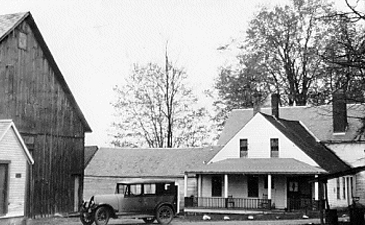 The year 1835 marked a change in ownership for the family homestead as the property was sold to Abial A. Walker from Westmoreland, New Hampshire. He and his wife, Sabrina Briggs put a few federal dollars into the old place and held it together for their son, George Albert Walker. This Walker was a vet of Company 1, 16th Vermont Regiment during the Civil War and somehow made it back in one piece to continue farming with his wife, Ellen Elmer. When George passed on to that “Great Hayfield in the Sky” at the age of 63, his son Charles George Walker and wife, Emma S. Reed took the baton for a stretch. Emma was the third great, great granddaughter of Isaac Miller through his daughter, Catherine, hence the family link to 1770.
The year 1835 marked a change in ownership for the family homestead as the property was sold to Abial A. Walker from Westmoreland, New Hampshire. He and his wife, Sabrina Briggs put a few federal dollars into the old place and held it together for their son, George Albert Walker. This Walker was a vet of Company 1, 16th Vermont Regiment during the Civil War and somehow made it back in one piece to continue farming with his wife, Ellen Elmer. When George passed on to that “Great Hayfield in the Sky” at the age of 63, his son Charles George Walker and wife, Emma S. Reed took the baton for a stretch. Emma was the third great, great granddaughter of Isaac Miller through his daughter, Catherine, hence the family link to 1770.
Charles passed on in 1915 at age 45 and his son, John Elmer Walker, our grandfather, purchased the business, as it was, from his mother. While the farm had been through, cows, sheep, chickens, tobacco, and more, John’s wife Emma A. Bunting must be credited with the Family Marketing Award as she started a roadside stand selling sandwiches, ice cream, sodas, candy and tobacco as well as extra fruit and vegetables from the garden. After her death in 1939, her daughter, Frances E. Manix, pumped the gas from the old collectible pumps everyone wants to buy and ran the store for her father until he remarried Ella Spicer in 1943. Frances left the farm to pursue a business career and eventually married a lanky, ex-WWII sailor and eventual railroad exec, Francis R. Manix. John and Ella enjoyed a successful business and dairy farm for many years. Tragedy struck in 1961, though, as Ella was robbed and shot in the neck by a young customer, the bullet causing permanent damage that forced John to give up the cows and much of the farming. Gramma Ella’s health went downhill after the incident and she died November 7, 1968.
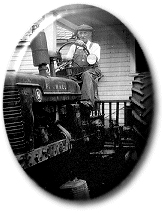 In 1973, John’s flatlander-raised grandson, Jack Walker Manix (yours truly), married his girlfriend and Boston University classmate, the fair-haired Miss Karen Jensen, in an outdoor ceremony at a picturesque old pasture surrounded by woods and the newlywed couple soon became part of the farm.
In 1973, John’s flatlander-raised grandson, Jack Walker Manix (yours truly), married his girlfriend and Boston University classmate, the fair-haired Miss Karen Jensen, in an outdoor ceremony at a picturesque old pasture surrounded by woods and the newlywed couple soon became part of the farm.
The first night, in a talk with Grampa John, they mentioned how nice it would be to have a cow back on the farm to which he rather quickly replied, “We’ll get one tomorrow.” And so they did. And so began their education. Jack and Karen were very surprised to learn one does not get milk by pumping the tail, the land can be measured in rods, and the sun comes up sometimes at five AM.
Grampa was a Vermont Yankee in the truest sense and the knowledge he passed on to them of farming and tending the land was of the kind not found in books. As other older farmers saw the couple struggle, they, too, provided the words of wisdom and encouragement that enabled the newcomers to press cider, boil down maple sap, raise chickens, cows, pigs, goats and sheep, measure logs and cordwood, rake winding windrows of hay, split locust posts, pull out stubborn calves at birth, rebuild 1944 farmtruck Flathead-8 engines, and plant little seeds that would grow into amazing plants. Together and with their daughter, Kristin, and son, Dustin, they continued the family tradition, often learning the hard way, but learning none-the-less.
Today, Walker Farm has evolved into a retail operation that prides itself in the quality of premium products and friendly service that have kept the farm successful and respected. Twenty-five greenhouses grow over 1200 annual and perennial flowers started from seed as well as hundreds of varieties of propagated plants from around the world plus all kinds of tasty, organic vegetables. Display gardens and the scenic views of the Connecticut River valley provide a splendid backdrop for a brilliant rainbow of spring bloomers offered for sale in the farm’s garden center. Thirty acres of carefully nurtured land supply the seasonal farmstand with flavorful, certified organic vegetables and fruit from June until Thanksgiving. Our Elysian Hills Tree Farm keeps the crew busy until Christmas Eve harvesting and selling our organically grown Canaan and Balsam fir holiday trees. The daily harvesting, the dedication of the wonderful staff, the background clucking hens, all combine to help keep the community in touch with the peacefulness of sustainable agriculture. The generations of Walker Farm each add their own signature to the ever-changing portrait that continues to remind one year by year of the temporary nature of the human condition and the fascinating permanence of the sacred land.
*Excerpts from Dummerston, An “Equivalent Lands” Town 1753-1986
Published by The Dummerston Historical Society, 1990
Edited by Alice Crosby Loomis and Frances Walker Manix







